[ad_1]
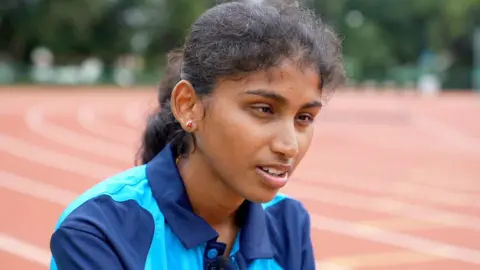 BBC
BBC“As I was growing up, everyone in my village would say: ‘She is blind and she is a waste.’ “He says.
Rakshita was born in a distant village in South India, and she lost her parents at the age of 10. He was raised by his grandmother, and the speech he heard is weak.
“We are both disabled, so my grandmother understands me,” he says.
When Rakshita was about 13 years old, her school’s sports teacher left her and said that she could be a great athlete for her.
“I wondered: ‘How? I am blind, so how can I run on a path that I can’t see?’
His teacher explained that the visionless race players may have a guide, running along with them. Athletes are attached to a Deather – a short strap with a rotation on both ends to keep them each.
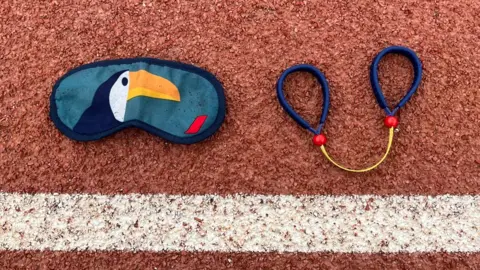
For a while, the other students acted as Rakshita’s guide players. Then in 2016, when he was 15 years old, he contested national games, where he saw a person called Rahul Balakrishna.
Rahul, a middle -distance runner, competed in the 1500 -meter match. A few years ago, a trainer was introduced to the Paralympic Committee (BCI) to Para Athletics, while he recovered the injury.
There was a shortage of guides and coaches, and Rahul decided to take both roles. The government gives him a salary to the training page of his work, but it does not pay for the guide runners.
However, if the visionless race player wins an international competition, their guide also receives a medal – Rahul does not reach his own running life. “I am proud that I can do this for me and for my country,” he says.
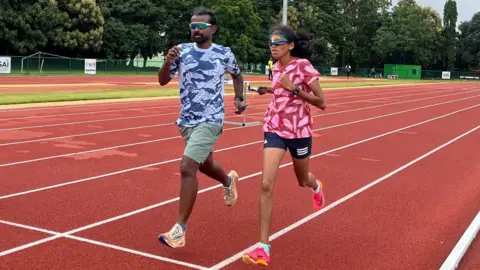
He invested his own time and money to support Rakshita, helping to go to Bangalore in 2018, so he can access the best training facilities.
Rahul says “It’s little things” when they are running. “When they approach a curve, the guide must warn the athlete or when a competitor overtake, he should tell the athlete so that they can try a little more.”
Competition rules mean that they cannot hold hands – only the Deather can be attached to them, and the guide -Runner is not allowed to push, pull or trigger the unwavering athlete.
Over time, this couple has tied a strong bond and now “I believe my guide race than me,” Rakshita says.
They won gold medals in 2018 and 2023 Asian Games and welcomed the village of Rakshita. She smiles when she describes how the people who ridiculed her, cheered, cheered, cheered, and waved.
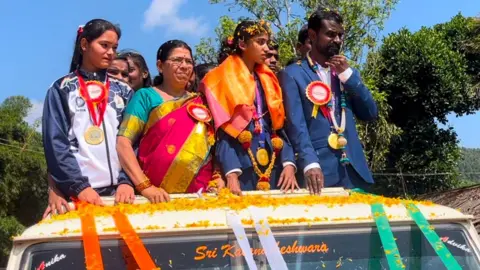
1500 m in Paralympic.
They missed a medal in France, but Sprinter Simran Sharma, the only female athlete in India, who had a visionary defective player to qualify for Paris, came to the stage and brought bronze at home.
Simran is somewhat, and as she started to run, she ran alone.
But in 2021, when Simran competed in Tokyo Paralympics, he went away from her path and realized that she needed a guide if she wanted to run.
But the search proved to be challenging. “It can’t be any athlete. You need someone, whose technique fits with you, and run as fast as you do,” he explains.
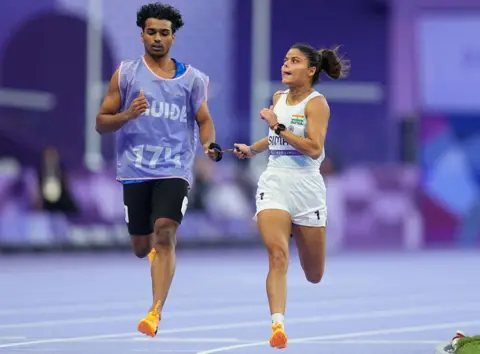 Getty pictures
Getty picturesSimran finally saw a young athlete named Abhay Kumar, and he trained like her. The 18 -year -old was between the competitions, and it was an opportunity to lead Simran to gain experience in international events.
“They sent me videos and after seeing them, I thought: ‘I’m a fast learner, this is easy’,” he says. “But when I ran for the first time, it became very hard.” Each movement must be synchronized.
Simran and Abe have no time to practice together in front of their first international competition – the 2024 World Para Athletic Championships in Japan – a few weeks later.
Their first race, 100m, ended in disaster.
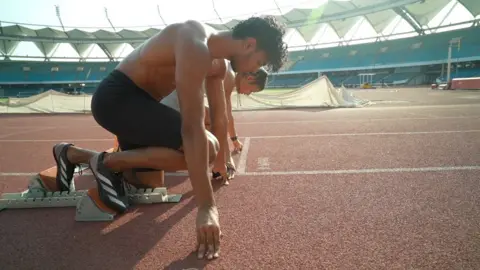
“We are not aware of the rules properly,” says Simran. Abhai “first thought he should let me over the border, so he stopped completely”. He must continue to go, because he must be behind and cross the line behind her.
But at the time they came to the 200 -meter run, they knew what they were doing and attacked the gold. Simran is the world champion in the D12 category.
Riding in that hike, they went to the Paralympic in Paris. They finished fourth in 100 meters, but won the bronze in the 200 -meter race, and Simran became the first Indian woman to win a Paralympic medal.
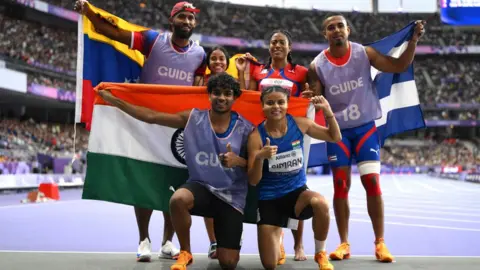 Getty pictures
Getty picturesBut Simran is worried about how long he will be his guide. He too has his own life to think.
Although a pair win, the guide running players receive a medal, but the Paralympic Committee (PCI) says that salaries cannot support the guides with cash prizes or provide a long -term career path.
“What we can do is to support short -term needs such as their food, shelter, transport and training facilities,” says Mr Satyanarayanan, National Athletics Coach of BCI.
Both Rakshita and Simran have sponsorship contracts now, which helps to finance their training. They pay their guides themselves, and give a share of any prize money they win. But Rahul and Abe prefer the state’s additional support, and want to allow the athletes and women to apply for public sector jobs for women – like the athletes they work.
Despite the uncertainty in his future with Abu, Simran is already facing the next Paralympic Games in Los Angeles. “I will not rest until I change the color of this medal,” he says, hoping that he will win gold next time.
The next time Rakshita is looking for a medal, Rahul is on his side. “She has to win a medal,” she says. “There are many like her in the villages. They don’t know about sports and possibilities. Rakshita will be a role model for them.”
The BBC Indian athlete (Iswotti) has returned to its fifth version to celebrate the significant achievements of female athletes in India. Learn about those who are recommended – The winner will be announced on February 17.
[ad_2]
Source link














